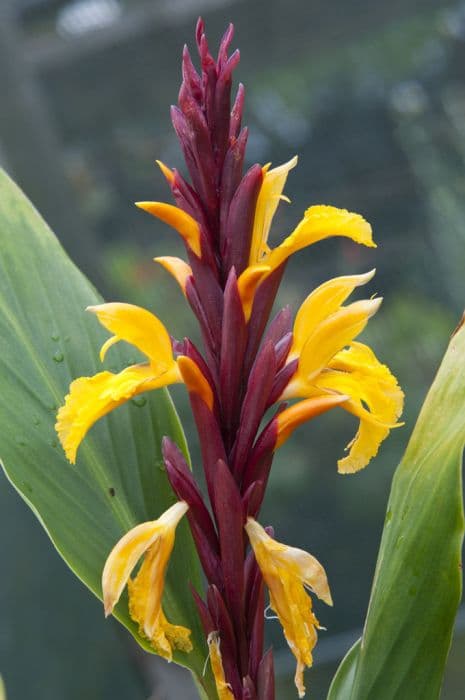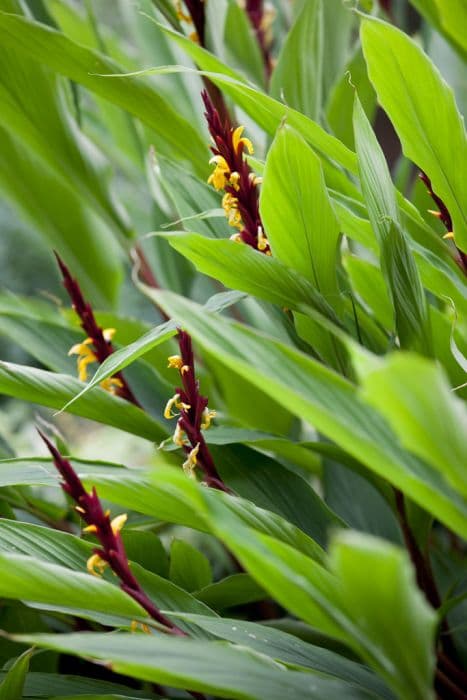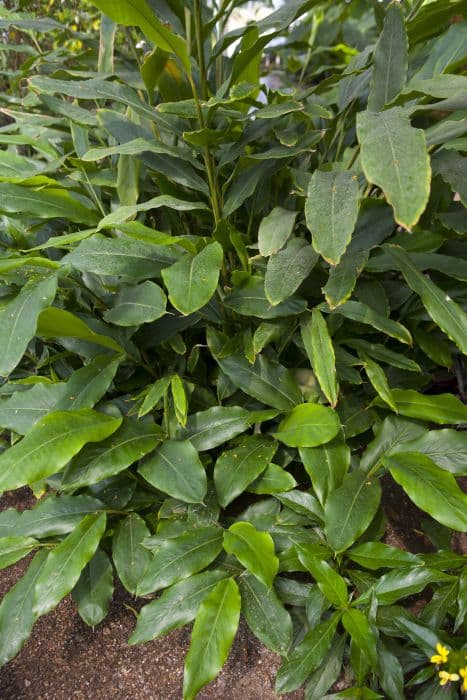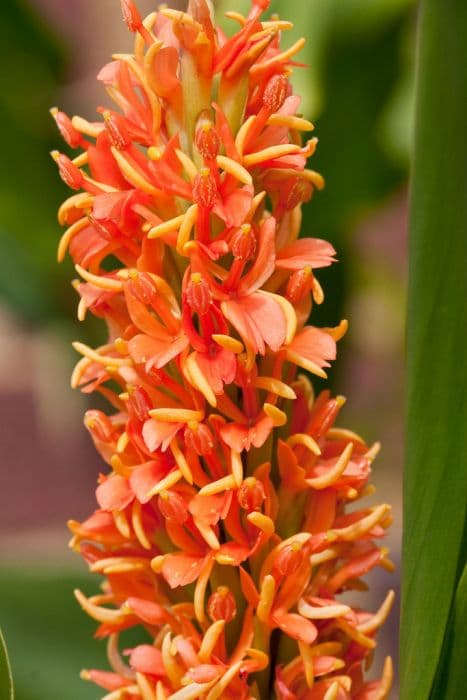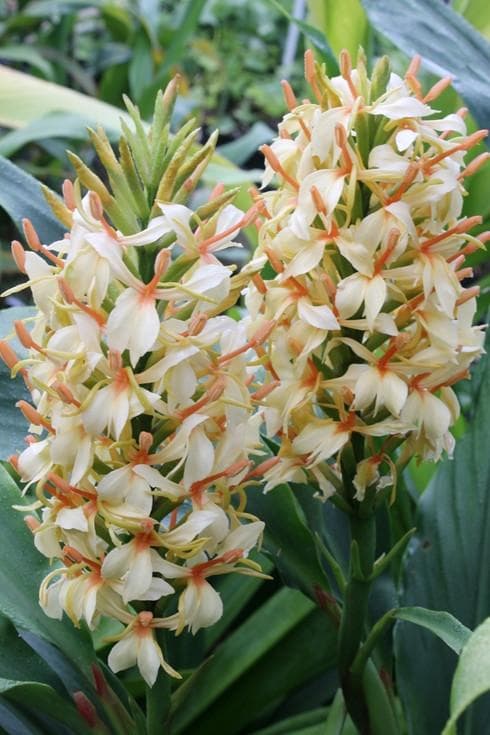Tibetan Roscoea Roscoea tibetica

ABOUT
Roscoea tibetica, also commonly known as Tibetan Roscoea, is a perennial herb with striking features. It forms a clump of narrow, lance-shaped green leaves that provide a lush backdrop for its unusual flowers. The blooms, which appear in summer, have an exotic look, with a funnel-shaped structure that can be purple, lilac, or occasionally white. These attractive flowers have a prominent lower lip and are often marked with deeper purple spots and stripes, which add to their ornamental appeal. Each flower is cradled by a small, green bract. The plant emerges from a rhizome beneath the soil, forming a base from which the leaves and stems rise. Tibetan Roscoea typically has an upright habit, with the leaves and stems standing straight as a backdrop for the beautiful and distinctive flowers.
About this plant
 Names
NamesFamily
Zingiberaceae.
Synonyms
Tibet Roscoea, Tibetan Roscoea.
Common names
Roscoea tibetica.
 Toxicity
ToxicityTo humans
Information specific to Roscoea tibetica, or Tibetan Roscoea, and its toxicity to humans is not widely documented in generalist texts on medical or horticultural toxicity. Therefore, it is assumed that it is not commonly recognized as a toxic plant to humans. However, since there is a lack of detailed information, it is always wise to err on the side of caution and not consume any part of plants that are not confirmed to be safe for human ingestion. If toxicity was present, symptoms would usually include digestive discomfort, nausea, vomiting, or more severe reactions depending on the nature of the toxic compound. Always consult with a healthcare provider or poison control if you suspect poisoning from any plant.
To pets
Information specific to Roscoea tibetica, or Tibetan Roscoea, and its toxicity to pets is not well-documented in sources focused on veterinary toxicology or pet care. Generally, without specific listings as a toxic plant, it can be assumed that Tibetan Roscoea is not commonly known to be hazardous to pets. As with humans, it is prudent to prevent pets from ingesting plants unless they are known to be non-toxic. If the plant were toxic, potential symptoms could include gastrointestinal upset, vomiting, diarrhea, drooling, or more serious systemic symptoms, depending on the type and amount of the toxic substance ingested. In the event your pet shows any unusual symptoms after ingesting any part of a plant, you should contact a veterinarian promptly.
 Characteristics
CharacteristicsLife cycle
Perennials
Foliage type
Deciduous
Color of leaves
Green
Flower color
Varies
Height
1-2 feet (0.3-0.6 meters)
Spread
0.5-1 feet (0.15-0.3 meters)
Plant type
Herb
Hardiness zones
6
Native area
Tibet
Benefits
 General Benefits
General Benefits- Aesthetic Appeal: Provides visual interest with its exotic-looking flowers and foliage.
- Low Maintenance: Requires minimal care once established, making it suitable for gardeners of all levels.
- Cold Hardy: Can survive in cooler climates and up to USDA zone 5, adding diversity to such gardens.
- Great for Pollinators: Attracts bees and other beneficial insects, promoting pollination in the garden.
- Long Flowering Period: Offers a prolonged blooming time from late spring to early summer.
- Shade Tolerance: Thrives in partial shade, making it ideal for woodland garden settings.
- Compact Size: Its small stature allows it to fit well in rock gardens or as a border plant.
 Medical Properties
Medical Properties- Anti-inflammatory: Roscoea tibetica may possess compounds that help reduce inflammation.
- Analgesic: Some components in the plant might be used to alleviate pain.
- Antioxidant: It might contain antioxidants, which can neutralize harmful free radicals in the body.
- Antimicrobial: The plant may have properties that help in fighting bacteria and other pathogens.
 Air-purifying Qualities
Air-purifying QualitiesThis plant is not specifically known for air purifying qualities.
 Other Uses
Other Uses- Roscoea tibetica, also known as Tibetan Roscoea, can be used in rock gardens to provide a unique texture and form given its distinctive foliage and flower structure.
- The plant can function as a seasonal ground cover in woodland gardens, creating an underlayer of green during its growth period.
- Known for its resilience to cold temperatures, Tibetan Roscoea can be used in alpine garden displays to add variation alongside other high-altitude plants.
- Due to its interesting floral shape, the plant can be incorporated into educational gardens that focus on plant diversity and morphology.
- The leaves of Tibetan Roscoea can be used in the art of leaf casting to create detailed sculptures and decorative pieces for garden ornamentation.
- The species may serve as a subject for botanical illustration and garden photography due to its unique appearance, contributing to art and cultural projects.
- The blooms can be used in floral arrangements temporarily, bringing an exotic touch to bouquets or table settings.
- Tibetan Roscoea can be planted as part of conservation efforts aimed at preserving species diversity within certain ecosystems or botanical collections.
- The plant can be used in culinary demonstrations to show the wide variety of edible flowers, although it is not commonly consumed.
- Cultivating Tibetan Roscoea can be a part of educational programs in schools or botanical gardens to teach about plant care and horticulture.
Interesting Facts
 Feng Shui
Feng ShuiThe Tibetan Roscoea is not used in Feng Shui practice.
 Zodiac Sign Compitability
Zodiac Sign CompitabilityThe Tibetan Roscoea is not used in astrology practice.
 Plant Symbolism
Plant Symbolism- Resilience: Roscoea tibetica thrives in harsh alpine climates, symbolizing the ability to persevere and flourish in challenging conditions.
- Rarity: As a less commonly known plant, it can represent uniqueness or the preciousness of rare finds in life.
- Adaptability: The plant's capacity to adapt to tough environments makes it a symbol of flexibility and the capability to thrive in different circumstances.
- Beauty in Simplicity: With its simple yet striking flowers, Roscoea tibetica symbolizes finding beauty in simple, understated forms.
- Connection to Nature: Native to the Tibetan plateau, it signifies a deep bond with the natural world and a respect for one’s origins.
 Water
WaterThe Tibetan Dragon Flower prefers consistently moist soil during the growing season, so it should be watered thoroughly once the top inch of soil starts to dry out. Depending on the climate, this usually means watering approximately once a week with about 1 gallon of water, though you'll need to adjust based on temperature and humidity. During winter, reduce watering to every other week to prevent waterlogging, as the plant goes dormant. It is important to ensure good drainage to avoid root rot.
 Light
LightTibetan Dragon Flower thrives in partial shade where it can receive filtered sunlight. A spot that offers morning sunlight and afternoon shade would be ideal for Roscoea tibetica. Direct afternoon sun should be avoided as it may scorch the delicate leaves of the plant.
 Temperature
TemperatureTibetan Dragon Flower performs best in temperature conditions that range between 50 and 75 degrees Fahrenheit. It is hardy down to about 10 degrees Fahrenheit, but extended exposure to temperatures below this minimum can damage the plant. Ideally, keep it protected from harsh, cold winds and frost for the best growth.
 Pruning
PruningPruning of the Tibetan Dragon Flower should be done primarily to remove spent flowers and dead or damaged foliage to encourage healthy growth and improve air circulation. This light pruning can be done in the late fall or early spring. Regular pruning is not extensive; just maintain the plant's shape and health.
 Cleaning
CleaningAs needed
 Soil
SoilTibetan Dragon Flower prefers well-draining, humus-rich soil with a pH of 6.0 to 7.5. A mixture of loam, perlite, and compost is ideal to ensure adequate drainage and fertility.
 Repotting
RepottingTibetan Dragon Flower should be repotted every 2-3 years to refresh the soil and accommodate root growth. Repotting is best done in spring as the plant emerges from dormancy.
 Humidity & Misting
Humidity & MistingTibetan Dragon Flower thrives at a humidity level of 40-70%. It is tolerant of a range of humidity conditions but prefers a more humid environment mimicking its natural habitat.
 Suitable locations
Suitable locationsIndoor
Provide bright light, moist soil, and good air circulation.
Outdoor
Plant in partial shade with shelter from strong winds.
Hardiness zone
6-9 USDA.
 Life cycle
Life cycleRoscoea tibetica, commonly known as Tibetan Roscoea, begins its life cycle as a seed, which upon finding suitable moist and cool conditions, germinates in the spring. The seedling then develops into a vegetative plant with elongated leaves, emerging from an underground rhizome. As it matures, it forms a distinctive stemless structure where the leaves are basal, arranged in a rosette form. The plant flowers in summer, producing striking purple to violet flowers that attract pollinators, crucial for the sexual reproduction stage. Following pollination, the flowers produce capsules containing numerous small seeds. As winter approaches, the aerial parts of the plant die back, and it enters a period of dormancy, with the rhizome surviving underground until the next growing season begins.
 Propogation
PropogationPropogation time
Spring-Early Summer
The most popular method to propagate Roscoea tibetica, commonly known as the Tibetan Roscoea, is through division. This is best done in spring just as the plant is coming out of dormancy. Carefully lift the plant from the ground and divide the rhizomes using a sharp knife, ensuring each section has at least one growth bud. These sections can then be replanted in the ground at a depth of roughly 2 to 4 inches (5 to 10 centimeters), allowing enough space for them to grow. It is vital to keep the soil moist but well-drained, and the plants should be situated in a part-shade location for optimal growth.
